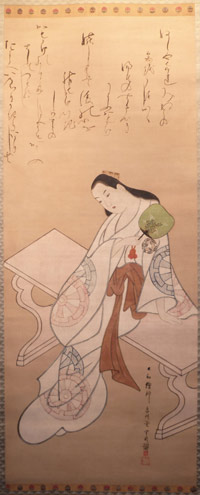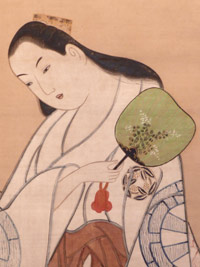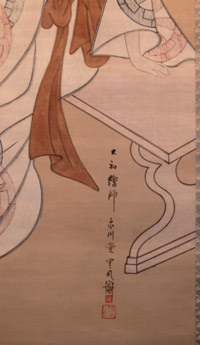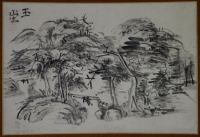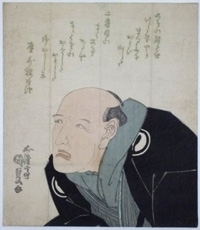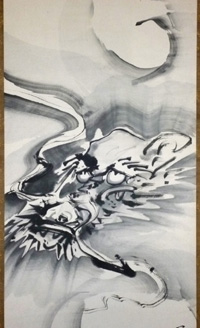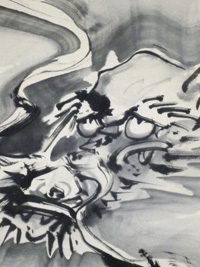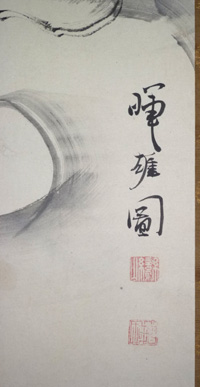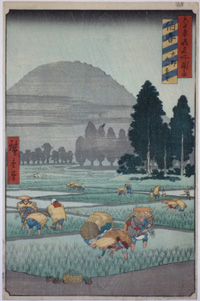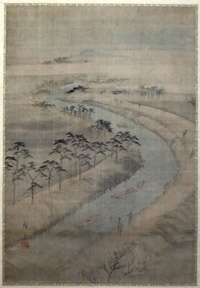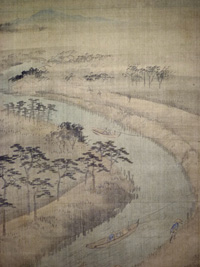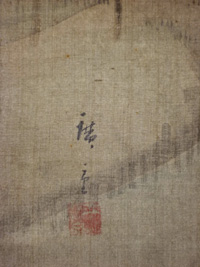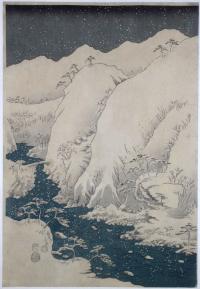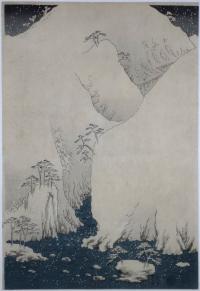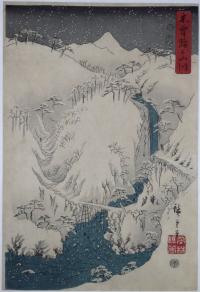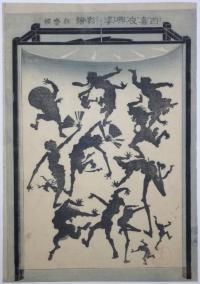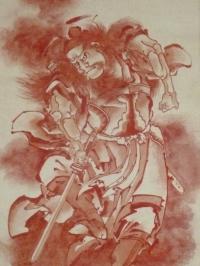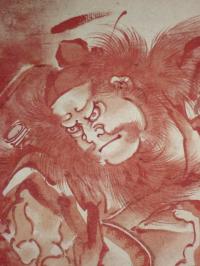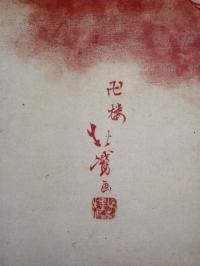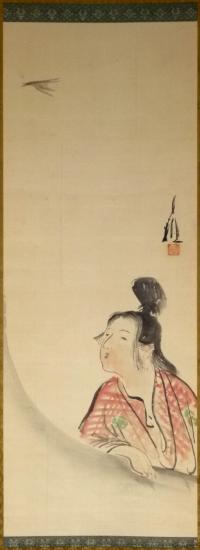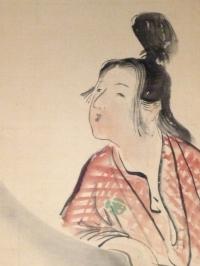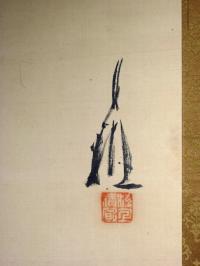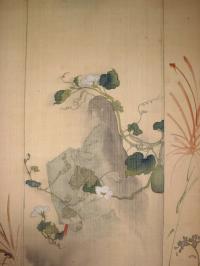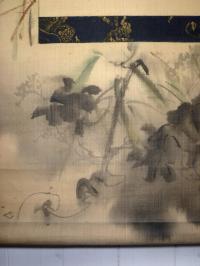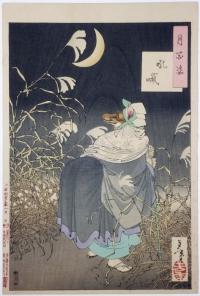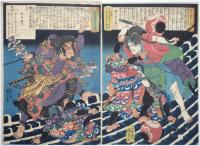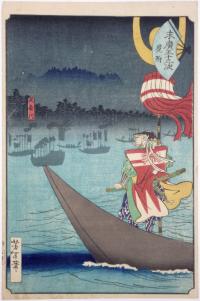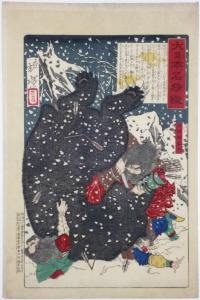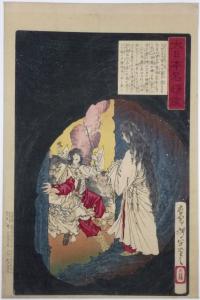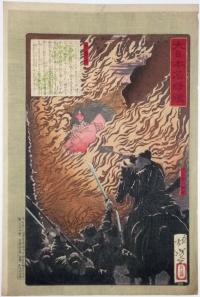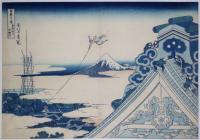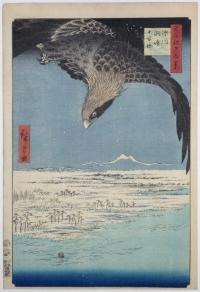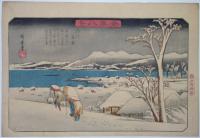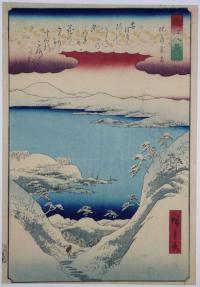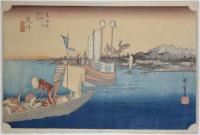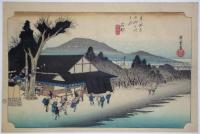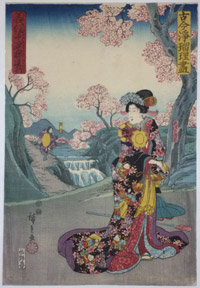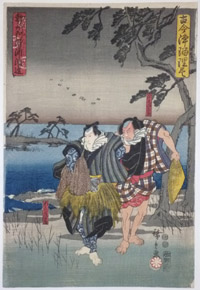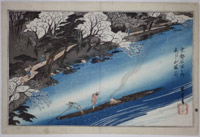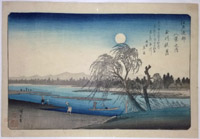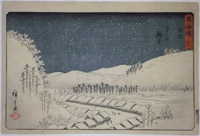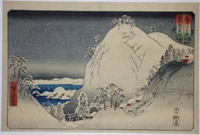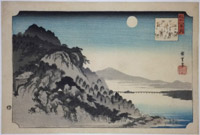/category/archive/page/33/
Tosendo RIFU (Active c. 1730)
Click here to view image full size.
Rifu was a member of the Kaigetsudo school, although little is known of his life. This beautiful painting shows a young woman in a voluminous robe cooling off in the summer. Full colour on paper with elements picked out in gold such as the comb, fan and robe. Lacquered hair. Image size 46 x 18.75in; 117 x 47.5 cms. Two other Rifu paintings are in the Idemitsu collection, see Ukiyo-e Paintings in the Idemitsu Collection, 1988, no 50 and 51. In very good condition for a painting of this period on paper. Mount in excellent condition. New box and presented with a futo-maki ( thick wooden roll to preserve the painting from damage ). Fully signed Yamato e-shi Tosendo Rifu zu. Yamato meaning the pride of being a Japanese painter as opposed to one imitating Chinese painting.
Status: Sold
Uragami GYOKUDO (1745-1820)
An original painting, sumi on paper. Image: 5.5 x 8.25 in; 14 x 21 cms. Shows a hilly landscape with a coppice cut through with a stream and two bridges. Gyokudo is now considered the leading exponent of Nanga painting. An artist whose spontaneous paintings often appear as though executed under deep emotion or when partially intoxicated. Now greatly admired in Japan and the West with many fakes. His father was of samurai rank and Gyokudo initially served a nobleman, Ikeda Masake, in Bizen. However, his passion for music, painting and verse composition caused him to become a wanderer in 1794. His Bohemian life eventually leading him to Kyoto where he joined the literati circles of Mokubei and Chikuden. Most paintings done after 1794 and this example probably dates to around 1800 – 1810. Tastefully remounted with double box. Signed and faintly sealed Gyokudo. Rare.
Status: Sold
Utagawa KUNISADA (1786-1865)
Click here to view image full size.
An extremely rare surimono: I have only seen one other impression and that was one I purchased around 20 years ago. Shows the most famous playwright of his age – Tsuruya Nanboku IV ( 1755 – 1829 ). His crest is clearly visible on his shoulders. He died on the 27th of the 11th month, 1829 and this surimono dates from shortly after that. This appears to be a sort of shini-e – very unusual in surimono form. He wrote the most famous Kabuki ghost story: Yotsuya kaidan, “Yotsuya Ghost Story” ( 1825 ) as well as the quick-change play Osome no nanayuki ( 1813 ).
Very good impression. Some creasing along laid lines and small restoration at top edge. Signed Gototei Kunisada ga.
Status: Sold
Soga SHOHAKU (1730-1781)
Click here to view image full size.
An enigmatic and unclassifiable artist who took the name Soga from Soga Jasoku, a fifteenth-century artist. He lived in Kyoto and is known to have abhored Okyo. Although admired for his dynamic brushwork by his contemporaries, he was considered – if not mad – certainly very eccentric. Now widely admired with many copies. Shows the Dragon of the Storm. A mythological creature that dominated Chinese and Japanese art. It was a scaly four legged serpent with dorsal spines, the head having two horns, long feelers, and flame-like streamers at the shoulders and hind quarters. What could be a hackneyed subject – especially in Kishi hands – but here transformed by the sheer brilliance of the brushwork. Sumi on paper, 47.5 x 14.5 in; 120.5 x 37 cms, c 1770s. Old mount with the painting in extremely good condition. Box of considerable age with inscription on lid: Soga Shohaku: Ranzan ka un ryu, “Soga Shohaku: Ranzan Dragon in the Cloud.” Underside of lid inscription states that it is from a collector’s rare collection and there are various undecipherable Japanese ( collectors’ ? ) seals. Signed Kiyu no zu with seals Ranzan and Soga shi. A masterpiece.
Status: Sold
Suzuki HARUNOBU (c 1725–1770)
Click here to view image full size.
A chuban print of a pair of oxen. One of the Junishi, Twelve Zodiacal Signs ( this being Ushi ). Complemented here by a red and white plum tree. People born in the Year of the Ox are known to be difficult but, once committed, they are loyal for life. And the plum tree symbolizes conjugal loyalty. Exceptionally rare: One other impression is illustrated in Yoshida, Harunobu zenshu, p. 112. Indeed, Harunobu designed very few kachoga, unlike Koryusai who made many a few years later. This could have been intended as one of a set of twelve prints, but the likelihood is that it is a single design. Published c 1767.
Fine impression with the outlines of the oxen heavily gauffraged. Exceptional condition: The background blue is from the dayflower ( Commelina communis L. ). One of the most fugitive pigments, here completely intact. The petals were collected at dawn, squeezed, and applied to paper which was used as a carrier. Very fine colour and condition. Signed Suzuki Harunobu ga.
Status: Sold
Ichiryusai HIROSHIGE (1797-1858)
Click here to view image full size.
A distant view of Mount Daisen [ Oyama ] in Hoki Province. One of the best designs from Rokuju yoshu meisho zue, “Famous Places in the Sixty-Odd Provinces.” The set published by Koshimuraya Heisuke between 7/1853 and 3/1856 ( this being 12/1853 ). White rain ( printed with gofun ) falls on groups of peasants planting rice. A lovely design, the edges of the paddy fields zig-zagging into the distance. This is the rare first edition with blue and yellow diagonal bands on the sub-cartouche.
Fine impression with strong woodgrain showing. Fine colour. Margins slightly trimmed and one small sumi smudge, otherwise fine. Another state of the first edition has the grey block and the mountain printed darker. Signed Hiroshige ga.
Status: Sold
Ichiryusai HIROSHIGE (1797-1858)
Click here to view image full size.
Kazusa Kuroto no ura, “The Bay of Kuroto in Kazusa” from a set Shokoku meisho zukai, “Famous Views of the Provinces.” An uncut fan print published by Iseya Soyemon, c 1854. Shows women in a ferry with ships being unloaded in the background and Mount Fuji beyond. Another design from the set is illustrated in Tamba, Hiroshige shodai, 1965, pl. 176. Hiroshige designed a number of fans in collaboration with Kunisada, but these are seldom successful designs as opposed to these “pure” compositions. Rare.
Fine impression and colour and, apart from a small backed hole, in fine condition. Signed Hiroshige ga.
Status: Sold
Ichiryusai HIROSHIGE (1797-1858)
Click here to view image full size.
An important original painting either prior and for the published print Yotsugi-dori, yosui hikifune, “Hauling Canal Boats, Yotsugi Road” from the Meisho Edo hyakkei, published 1857; or painted at the same time because of particular satisfaction with the design. The canal supplied drinking water to the Fukagawa area. It also provided a regular passenger boat service heading northeast. There is some artistic license as the canal was fairly straight, which would not have provided such an interesting composition. Sumi and light blue on thin silk. ( Unique to Hiroshige as he had a penchant for rather coarse silk. ) 24.5 x 16.75 in; 62.25 x 42.5 cms. Good condition. From the collection of a leading supplier of tea ceremony utensils in Tokyo. Signed Hiroshige ga with Ichiryusai seal. ( For the same signature and seal, see Dr Timothy Clark, Ukiyo-e Paintings, B.M., no 141. )
Status: Sold
Ichiryusai HIROSHIGE (1797-1858)
Click here to view image full size.
An iconic image from Hiroshige’s oeuvre: Mountains and Rivers on the Kiso Road, Kisoji no yamakawa. A majestic snow scene showing a rugged part of the Kisokaido Road. One of the oldest in Japan, becoming less important after the Tokaido Road was constructed, which was faster and easier. Although no series title this is from a trinity of designs depicting Snow ( as here ), Moon and Flowers. These were the last three great prints Hiroshige designed. All are rare, especially Snow and Moon. Published 1857 by Okasawaya Taheiji.
Fine impression and colour. Slight yellowing of the paper, otherwise fine condition. Completely untrimmed. Matching sheets with extra paper all round. ( These three designs are martyres to trimming. ) Signed Hiroshige hitsu.
Status: Sold
Manjiro HOKUGA (Fl. Early 19th Century)
Click here to view image full size.
A pupil of Hokusai who specialised in Surimono and book illustration. Used Hokuga signature until 1810, then Hotei Gosei. Shows Shoki, the demon quellor, descending to earth on a vapour cloud wielding a sword in order to vanquish demons. Painted entirely in red pigment. The subject matter and use of red ink comes from China. The colour was thought to exorcise evil spirits and was used to ward off illness. Red pigment on paper. Image size: 37.5 x 10.75 in; 95.5 x 27.5 cms. Very good condition. Old box. A fine painting exhibited and published: Itabashi Kuritsu Bijyutsukan, Hokusai and his followers – the collection of the best Ukiyo-e paintings. Exhibition Catalogue, Tokyo, 2008, pl. no. 57. Signed Manjiro Hokuga ga with seal Manjiro.
Status: Sold
Ogata GEKKO (1859-1920)
Click here to view image full size.
Gekko was a founding member of the Bunten and frequent prize winner. As well as designing prints, he illustrated magazines and decorated pottery. A talented artist who developed his own distinctive style. A young girl and a cuckoo. The first cuckoo traditionally heralds the arrival of summer and is usually shown flying across or near the moon – here represented by the circular window. And it might not be too fanciful to see the arrival of the cuckoo compared to the coming of age of the young girl. Sumi and colour on silk. Image size: 37 x 14 in; 94 x 35.5 cms. Very slight damage to bottom of washira mount. New box. Signed and sealed Gekko.
Status: Sold
Watanabe SEITEI (1851-1918)

Click here to view image full size.
A fascinating painting by Seitei in homage or as a commission inspired by Yoshitoshi’s ghost print: The ghost of Genji’s lover, Yugao, from Tsuki hyakushi, published 3/1886. Another unusual element is that Seitei has painted the outline of the scroll and the ichimonji and gone beyond, painting a surround of wild grasses and wispy clouds on what would be the kami and chu-mawashi. Seitei was famous for his depictions of birds and flowers and this is, again, a most unusual departure for him. One of Seitei’s masterpieces. Sumi and light colour on silk. Full size: 65.5 x 13.25 in; 166.5 x 33.5 cms. Light foxing at top, otherwise good condition with ( not original ) box. Signed Seitei Watanabe ga and dated kanoe Tora ( year of the Tiger, 1890 ) chugetsu, “Moon in Daylight.” Sealed Seitei.
Status: Sold
Tsukioka YOSHITOSHI (1839-1892)
Click here to view image full size.
A fox priest from Tsuki hyakushi, “One Hundred Phases of the Moon.” Based on the Kyogen farce Konkai, “A Fox’s Cry” which tells of a hunter who is lectured on trapping foxes by his uncle, a priest. On his way home his uncle turns into his true form, a fox, and is snared in a trap. Yoshitoshi’s design shows the uncle transmogrifying into a fox. The set published by Akiyama Buemon between 1885 – 92, this design issued 1/1886. One of the best designs from the set.
Very good impression and colour. Retains original light album backing. Signed Yoshitoshi
Status: Sold
Ichiyusai KUNIYOSHI (1797-1861)
Click here to view image full size.
Shows Inudzuka Shino Moritaka defending himself against Inukai Kempachi Nobumichi and his men on the Horyukaku roof. From a set of four diptychs ( often split ) published by Nishimuraya Yohachi, c 1835. Robinson S 5.6.
Very good impression. Fine colour and condition. Completely untrimmed. Signed Ichiyusai Kuniyoshi ga.
Status: Sold
Tsukioka YOSHITOSHI (1839-1892)
Click here to view image full size.
Mariko from the Fifty-Three Stations of the Tokaido Road. The set designed by several artists and various publishers to commemorate the journey of the Shogun from Edo to Kyoto in 2/1863. The best Yoshitoshi design from this set. Shows a battle fleet outside Mariko. Published by Yamaguchi 5/1865.
Very good impression and colour. Small fibre loss at extreme left edge. Very good condition. Signed Yoshitoshi fude.
Status: Sold
Ichiyusai KUNIYOSHI (1797-1861)
Click here to view image full size.
The pilot and nobleman Yoshibei leaps from his vessel to a rock in the Chopping Block Shoals and sacrifices himself to save his ship off the coast of Buzen Province. Meisho Kyushu yori joraku no toki. Published c 1850 by Santetsu. A wonderful and rare triptych which is seldom illustrated. Robinson T251.
Extremely fine impression. Fine colour and condition. Totally untrimmed. Colours do not quite match across the three sheets – a common fault on 19th century triptychs. Signed Ichiyusai Kuniyoshi ga.
Status: Sold
Tsukioka YOSHITOSHI (1839-1892)
Click here to view image full size.
Abe no Hirafu slaying a giant bear from Dai Nippon meisho kagami, “Mirror of Famous Generals of Japan.” A set of 51 prints published between 1876 and 1882 by Funazu Chujiro. ( This being 1880. ) Probably the best design from the set.
Very good impression, colour and condition. Full size. Signed Oju Yoshitoshi ga.
Status: Sold
Tsukioka YOSHITOSHI (1839-1892)
Click here to view image full size.
Amaterasu Omikami appearing from the cave from Dai Nippon meisho kagami, “Mirror of Famous Generals of Japan.” A set of 51 prints published between 1876 and 1882 by Funazu Chujiro. ( This being 1882. ) One of the best designs from the set showing the famous story of Amaterasu – the Sun Goddess who had enclosed herself in a grotto with a large rock blocking the entrance causing darkness in the universe. She was tempted to peep out from the cave by the raucous activities of the other gods and goddesses whereupon she glimpsed herself in a mirror and the stone door was quickly fastened back by Ame no Tajikara.
Very good impression, colour and condition. Full size. Signed Oju Yoshitoshi ga.
Status: Sold
Tsukioka YOSHITOSHI (1839-1892)
Click here to view image full size.
Kamitsukeno Yatsunada attacking Saohime’s castle from Dai Nippon meisho kagami, “Mirror of Famous Generals of Japan.” A set of 51 prints published between 1876 and 1882 by Funazu Chujiro. ( This being 1880. ) One of the best designs from the set showing Saohime perishing in the flames of her brother’s castle – Saohiko – who had conspired with his sister to seize the throne.
Very good impression, colour and condition. Full size. Signed Oju Yoshitoshi ga.
Status: Sold
Katsushika HOKUSAI (1760-1849)
Click here to view image full size.
Toto Asakusa Honganji, “Fuji from the Roof of the Hongan Temple, Asakusa, in the Eastern Capital” from Hokusai’s most celebrated set: Fugaku sanjurokkei, the “Thirty-Six Views of Mount Fuji.” The set of 46 prints published by Eijudo, c 1830-32. This appears to be a New Year view judging by the kite being flown and the drum tower being erected to the left. The workmen repairing the roof, to the right, would also appear to be preparing for the New Year.
Very good impression: Blue outline. ( Later editions have black, but these impressions are very late. ) Known with and without red Eijudo and kiwame seals. Slight centre fold and several backed pin holes at bottom and left side at base. Signed Zen Hokusai Iitsu hitsu.
Status: Sold
Ichiryusai HIROSHIGE (1797-1858)
Click here to view image full size.
Kameido Umeyashiki, “The Plum Garden at Kameido.” Umeyashiki is the name of the plum garden on the bank of the Sumida River behind the Tenman Shrine at Kameido. From Meisho Edo hyakkei, the “One Hundred Views of Edo” published by Uoei between 1856 and 1858 ( this being 1857 ). A famous design because of Van Gogh’s 1887 copy. The tree was called Resting Dragon Plum and the branches grew so long that they penetrated the ground resulting in new shoots.
Good impression. Very good condition and colour. Signed Hiroshige ga.
Status: Sold
Ichiryusai HIROSHIGE (1797-1858)
Click here to view image full size.
Fukagawa Suzaki jumantsubo. The one hundred-thousand tsubo [ an area of measure ] plain, Suzaki, Fukagawa, from Meisho Edo hyakkei, the “One Hundred Views of Edo” published by Uoei between 1856 and 1858 ( this being 1857 ). An eagle hovers over the snowy coastal plain at Suzaki with Mount Tsukuba and the Chiba mountains in the distance. This and the other similar designs from the set with large foreground objects were of particular interest to the Post Impressionists, and indeed, this design was considered by many collectors at the turn of the 19th century to be the finest print from the set. It is still judged to be one of the major designs.
Very good impression. Fine colour. Very good condition. Signed Hiroshige ga.
Status: Sold
Ichiryusai HIROSHIGE (1797-1858)
Click here to view image full size.
“Evening Rain at Kozumi”, Kozumi no yau from the early set Kanazawa hakkei, “Eight Views in Kanazawa” published by Koshimuraya Heisuke, c 1835-6. This is an extremely rare and fine set and examples in good condition are very difficult to find. Each print contains a classical 31-syllable waka poem above. Kanazawa sits on the Sea of Japan bordered by the Japan Alps. One of Hiroshige’s finest compositions.
Very good impression. ( Later states have a mountain range printed in the background and a different colour scheme. ) Fine colour and condition with large margins. The publisher’s mark and censor seal intact in right margin. Signed Hiroshige ga.
Status: Sold
Ichiryusai HIROSHIGE (1797-1858)
Click here to view image full size.
“Evening Snow at Uchikawa”, Uchikawa bosetsu from the early set Kanazawa hakkei, “Eight Views in Kanazawa” published by Koshimuraya Heisuke, c 1835-6. This is an extremely rare and fine set and examples in good condition are very difficult to find. Each print contains a classical 31-syllable waka poem above. Kanazawa sits on the Sea of Japan bordered by the Japan Alps. One of Hiroshige’s finest compositions.
Fine impression and colour. Slight yellowing of the paper, otherwise fine condition. Completely untrimmed. Matching sheets with extra paper all round. ( These three designs are martyres to trimming. ) Signed Hiroshige hitsu.
Status: Sold
Ichiryusai HIROSHIGE (1797-1858)
Click here to view image full size.
Hira bosetsu, “Evening Snow at Mount Hira” from the vertical Omi Hakkei set of eight views of Lake Biwa. Published by Uoya Eikichi, Snake 7, 1857. Omi is the largest freshwater lake in Japan which serves as a reservoir for the cities of Kyoto and Otsu.
Superb impression of the first edition. Fine colour. Several minor marks and lower margin trimmed slightly, otherwise fine. Signed Hiroshige ga.
Status: Sold
Ichiryusai HIROSHIGE (1797-1858)
Click here to view image full size.
Arai watashibune no zu, “Ferry Boats at Arai.” Shows ferry boats outside the barrier – seen on the far shore –which was one of the most important on the Tokaido. From Hiroshige’s most famous set: Tokaido gojusan tsugi no uchi, “The Fifty-Three Stations of the Tokaido.” The set jointly published by Takenouchi Magohachi ( Hoeido ) and Tsuruya Kiemon ( Senkakudo ), 1833-34
Very fine impression ( first edition ? ) with beautiful bokashi. Slight centre fold, otherwise fine condition and colour. Signed Hiroshige ga.
Status: Sold
Ichiryusai HIROSHIGE (1797-1858)
Click here to view image full size.
Ishibe Megawa no sato, “Megawa Village near Ishibe” from Hiroshige’s most famous set: Tokaido gojusan tsugi no uchi, “The Fifty-Three Stations of the Tokaido.” The set jointly published by Takenouchi Magohachi ( Hoeido ) and Tsuruya Kiemon ( Senkakudo ), 1833-34. Shows travellers and revellers passing a tea house. There are temples near Ishibe that date from the Nara Period ( 701 – 784 ).
Very fine impression of what must be the first edition with beautiful gradation. Minimal soil top left corner, otherwise fine condition and colour. The best example of this design I have ever seen. Signed Hiroshige ga.
Status: Sold
Ichiryusai HIROSHIGE (1797-1858)
Click here to view image full size.
Tsuchiyama haru no ame, “Spring Rain at Tsuchiyama” from Hiroshige’s most famous set: Tokaido gojusan tsugi no uchi, “The Fifty-Three Stations of the Tokaido.” The set jointly published by Takenouchi Magohachi ( Hoeido ) and Tsuruya Kiemon ( Senkakudo ), 1833-34. Shows a daimyo’s procession crossing the Tamura River in Suzuka Pass, east of Tsuchiyama. The area is famous for its green tea and infamous for the treacherous pass in winter.
Very good early impression. Imperceptible centre fold and paper flaw at bottom left edge. Very good colour. ( Interestingly, a different pigment was used for the seals on this design which oxidises to a brown colour, rather than the usual red. ) Signed Hiroshige ga.
Status: Sold
Ichiryusai HIROSHIGE (1797-1858)
Click here to view image full size.
Taira no Kiyomori kaii o miru zue, “Taira no Kiyomori Haunted by Strange Sights.” Towards the end of his life, Kiyomori, the head of the Taira clan, was obsessed with and hallucinated that his vanquished enemies had come back for retribution. Shows Kiyomori and his lover on the engawa of the palace confronted by a multitude of snow covered sculls and skeletons in the garden. Published by Kinseido, c 1845. Hiroshige’s best musha-e triptych. A much sought after and rare design.
Fine impression, colour and condition. Signed Hiroshige ga.
Status: Sold
Ichiryusai HIROSHIGE (1797-1858)
Click here to view image full size.
Yoshitsune senbon zakura, “Yoshitsune and the Thousand Cherry Trees” from an extremely rare set: Kokon joruri tsukushi, “Ancient and Modern Dramas Illustrated.” The set published c 1846 by Sanoki. Basil Stewart listed 14 known designs in his Subjects Portrayed in Japanese Colour-Prints, Kegan Paul, 1922, p. 308 and this was updated to 15 by Strange in 1925 ( which still seems to be the known number extant for this set ). Shows the fox Tadanobu and Yoshitsune’s lover Shizuka-gozen.
Very fine impression, colour and condition. Signed Hiroshige ga.
Status: Sold
Ichiryusai HIROSHIGE (1797-1858)
Click here to view image full size.
Seishu Akogi no ura. Akogi no Heiji being arrested for fishing in forbidden waters from an extremely rare set: Kokon joruri tsukushi, “Ancient and Modern Dramas Illustrated.” The set published c 1846 by Sanoki. Basil Stewart listed 14 known designs in his Subjects Portrayed in Japanese Colour-Prints, Kegan Paul, 1922, p. 308 and this was updated to 15 by Strange in 1925 ( which still seems to be the known number extant for this set ).
Very fine impression, colour and condition. Signed Hiroshige ga.
Status: Sold
Ichiryusai HIROSHIGE (1797-1858)
Click here to view image full size.
Chushin koshaku yukifuri no dan, “Meeting of the Loyal Ones in Snow” from an extremely rare set: Kokon joruri tsukushi, “Ancient and Modern Dramas Illustrated.” The set published c 1846 by Sanoki. Basil Stewart listed 14 known designs in his Subjects Portrayed in Japanese Colour-Prints, Kegan Paul, 1922, p. 308 and this was updated to 15 by Strange in 1925 ( which still seems to be the known number extant for this set ). A snow scene showing Yazama Jiutaro, one of the 47 Ronin, meeting his wife Orin in Edo after a long separation.
Very fine impression, colour and condition. Signed Hiroshige ga.
Status: Sold
Ichiryusai HIROSHIGE (1797-1858)
Click here to view image full size.
Heavy snow with geisha in front of the torii in the Gion district of Kyoto. From the set of 10 prints Kyoto meisho no uchi, “Famous Views of Kyoto.” Published by Eisendo c 1834. The first edition of this design has the publisher’s mark and kiwame seal in blue in right margin. This impression, although the second edition, is still much sought after and rare.
Very good impression and colour. Imperceptible centre fold and minor marks in margin, otherwise good condition. Signed Hiroshige ga.
Status: Sold
Ichiryusai HIROSHIGE (1797-1858)
Click here to view image full size.
Arashiyama manka, “Cherry Trees in Full Bloom at Arashiyama” from the set of 10 prints Kyoto meisho no uchi, “Famous Views of Kyoto.” Published by Eisendo c 1834. Arashiyama, to the west of Kyoto, was the place to admire the cherry blossom. Shows men poling a large raft down the Hosu River. Numerous states exist of this design: some with variant gradation on the river, others with colour variations on the far bank.
Very good impression. Slight fading. Imperceptible centre fold. Minor marks in margin, otherwise good condition. Signed Hiroshige ga.
Status: Sold
Ichiryusai HIROSHIGE (1797-1858)
Click here to view image full size.
Tamagawa no shugetsu, “Autumn Moon over the Tama River” from the early set Edo kinko hakkei, “Eight Views in the Environs of Edo.” The set was first privately printed for the Taihaido poetry club by Sanoya Kihei ( Kikakudo ) c 1837-8 with three poems on each design. For obvious reasons examples from this edition are of the utmost rarity. The set was then re-issued with one poem on each ( as here ). Even examples of these are rare. Shows dusk falling over the Tama River whose source was Mount Tanba. The river was full of freshwater trout and fishermen can be seen on the river bank. Unidentified collector’s seal bottom left.
Very good impression and colour. Tips of upper two corners repaired, otherwise very good condition. Signed Hiroshige ga.
Status: Sold
Ichiryusai HIROSHIGE (1797-1858)
Click here to view image full size.
Mariko from Tokaido gojusan tsugi, “The Fifty-three Stations of the Tokaido”. The so-called Reisho Tokaido. Published by Maruya Seijiro, c 1851-2. Although Mariko, it probably shows the mountain village of Utsunoya on the way to the next station, Okabe. In contrast to most snow scenes where the earliest states have light blue graduated skies, this is only known with a slate-grey sky.
Fine impression. Very good colour. Imperceptible centre fold, otherwise very good condition. Signed Hiroshige ga.
Status: Sold
Ichiryusai HIROSHIGE (1797-1858)
Click here to view image full size.
Bizen, Yukazan. A figureless snow scene and the best design from the set of twenty prints entitled: Sankai mitate sumo, “Mountains and Sea Contending like Wrestlers”- one of the most poetic of his titles which is in an umpire’s fan used for wrestling matches, top right. The set published and sealed Horse 7 and 8 ( 1858 ) by Yamadaya. ( Happer lists it as the previous Horse Year 1846. ) One of Hiroshige’s last designs and rare. The set is divided into ten designs of mountains and ten prints of harbours.
Very fine impression of the first edition ( variegated cartouche ). Fine colour. Imperceptible centre fold and the usual oxidation, otherwise very good condition. Signed Hiroshige ga.
Status: Sold
Ichiryusai HIROSHIGE (1797-1858)
Click here to view image full size.
Tsukudajima hatsu hototogitsu, “The First Cuckoo at Tsukudajima Island” from Hiroshige’s first major landscape set of ten prints with title Toto meisho published by Shoeido c 1831-2. Shows a few boats off the Island in the Bay of Edo as seen from Eitai Bridge. To the right the Shiba district and on the left the tip of Honju Fukugawa. This is the rare first state with ochre border, graded blue on the water, and with the publisher’s name and address in right margin.
Fine impression and colour. Imperceptible centre fold. Large margins with publisher’s name and address in right margin intact. ( It is often trimmed, eg the Pulverer impression, pl. 6, Hiroshige, Matthi Forrer, 1997. ) Very good condition. Signed Hiroshige ga.
Status: Sold
Ichiryusai HIROSHIGE (1797-1858)
Click here to view image full size.
Autumn moon at Ishiyama, Ishiyama no shugetsu, from the set of eight prints: Eight Views in Omi Province published 1834 by Hoeido. “Eight Views” was borrowed from Chinese poetry and each print conveys, pictorially, the kyoka poem written in the square label at the top right. To the left, hidden in trees, is the temple where Murasaki Shikibu ( c 978 – c 1014 ) wrote her great novel Tales of Genji. The scene shows Lake Biwa, Seta Bridge and Mount Hira on the horizon. Hiroshige probably never surpassed the ethereal, figureless quality this set possesses.
Very good impression, colour and condition with good margins. The top-left mountain always shows slippage of the blue block on this design. The set was advertised as a “work in black and white, lightly coloured” and early states have a very limited palette. Later editions of this design incorporate green and brown into the cliffs on the left. Signed Hiroshige ga.
Status: Sold
